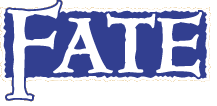
Spirit of Dungeon & Dragons

i, Ui, Ui was muss ich da in der Fate 3.0 Yahoo Group grad eben lesen? Bill Burdick will das D&D-Material der 4. Edition so aufbereiten um es in das Fate 3.0 System zu implementieren. Kein sooo leichtes Unterfangen. Nach eigener Aussage stellt die 4. Edition von Dungeon &Dragons einfach haufenweise cooles Zeug bereithält mit dem er spielen will. So verkehrt kann es ja nicht sein ein Monsterkompendium für Fate 3.0 zu haben ;-). Andererseits… Ich bin was die Idee angeht echt zweispältig ob ich das gut oder nicht so gut finden soll. Im Original schreibt Er:
The Conversion is supposed to be a FATE implementation „enhanced by 4e
concepts“ that allows you to use stock D&D 4e material without too
much trouble (monsters, powers, feats, classes, etc.) We playtested a
combat last nite and the fundamental techniques I’m using seem to be
working. I don’t have a name for it yet, which is why I’m calling it
„The Conversion“ (perhaps The Subversion is better?)The Conversion has aspects, zones, stress, consequences, skills, fudge
dice, etc. but the characters have classes, powers, feats (instead of
stunts), and attributes. Advancement uses a modified version of the
D&D advancement table (with skill points, stress boxes, and skill
points on it, among other things). Combat takes place on a map of
SotC-style zones but there are more combat features, like conditions
(from the PHB) and engagement groups (a clump of miniatures in a zone)
and I think it reasonably models push, pull, slide, shift, bursts,
blasts, opportunity attacks, etc. even though the map lacks a grid
(without even too much extra crunch, I think).Skills have the same scope as in SotC, but they’re a lot closer to PDQ
qualities because you make them up. The attack numbers for powers and
your defense numbers are based on your highest available skill level
for the relevant attribute. Despite the fact that Puzzle Making
seemingly has nothing to do with combat, if it’s your highest int/dex
skill, it’s the basis for your AC and Reflex. The highest skill for a
given attribute is taken as representative of your level. This allows
us to dispense with „add 1/2 your level“ to everything. We could just
set every skill at 1/2 your level, but I like point distribution,
because it adds much more variety to the characters. Instead of a
pyramid, there is a maximum skill level allowed at each character
advancement level (as well as the total available skill points).One of the major challenges in designing The Conversion was the
completely different way the two systems model damage. D&D uses an
absolute damage scale and FATE uses a relative damage scale. Since
D&D uses „skirmisher“ monsters as its standard (according to the DMG),
I hashed through a bunch of damage numbers for skirmishers and found a
(thankfully) pretty linear progression. Using this, I was able to map
monster level to expected damage from a successful hit and found that
that also corresponded with the numbers for PCs. This wasn’t too much
of a surprise, given all of the talk about the work they did on
balance, but it was still nice to see.Right now, I have an advancement table, enhanced rules for FATE
combat, and a damage output table. Converting powers on the fly was
time consuming, but I think power cards are the way to go for this
(and keeping the work around, once a power is converted). I’m working
on better tables and tools to simplify the conversion process.We played D&D 4e for 5 months and switched back to FATE because we all
really like FATE a lot better and our experience was that D&D
encounters took up a large portion of total game play. Epic battles
in FATE don’t have to monopolize an evening and yet somehow there is
no noticeable loss of epic. That said, D&D 4e has a lot of fun things
to offer. Level-based advancement has a lot going for it, for
instance. There’s that anticipation of getting to Nth level because
it has that one cool feature that you just don’t get with an a la
carte system. Characters and monsters „have a level“ which gives you
a good indication of their relative power. There are tons cool things
about D&D 4e, which is why I want to play it in FATE (is that so wrong?)Here is the document with our notes:
http://spreadsheets.google.com/pub?key=pGuL7SccMEaNCNXoYFDTTXgIf anyone is interested in helping out with this effort, please let me
know; it’s a big job!Bill
Links:

